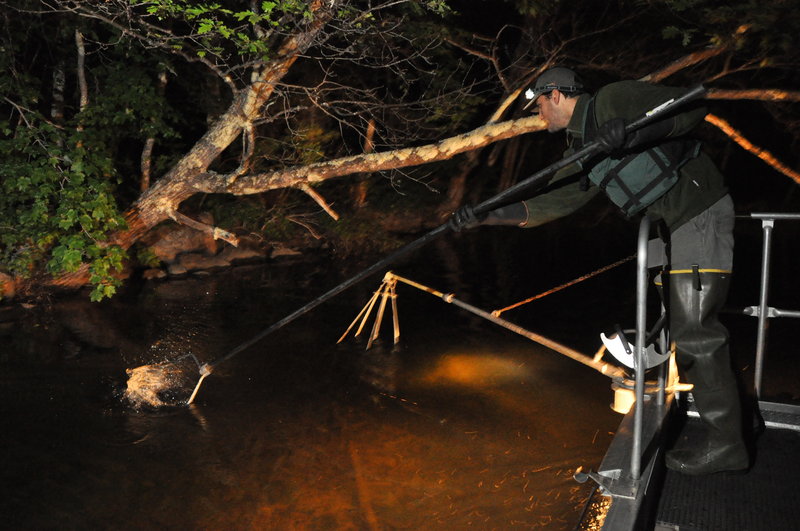So what is your ideal bass fishing boat?
I had one in mind, but after “fishing” one night earlier this summer with three fisheries biologists from the Department of Inland Fisheries and Wildlife, I am thinking about changing that.
This fishing trip netted more than 30 bass, including two that weighed more than 5 pounds, from a freshwater lake probably less than an hour from where you live.
This isn’t any ordinary boat, and you certainly aren’t going to find it in this week’s “Uncle Henry’s.”
The physical dimensions may seem run of the mill at 18 feet long with an 8-foot beam, but the 5,000-watt generator that surges an electric current through the shallows certainly isn’t.
It’s an electrofishing boat, and it is quite unlike anything you’ve ever fished from.
Instead of fishing rods, we lowered two aluminum booms over the water’s surface; and at the end of the booms, no sense using fishing lines or lures, we hooked up an electrical cable with an umbrella rig of electrodes to suspend in the water.
As the commercial goes, just flip a switch, and we’re there. In this case, flip a switch, and this rig pulses 5,000 watts of electricity through the water from boom to boom, using the hull of the boat as a ground to complete the circuit.
In essence, there is an electrical current that travels through the water about 10 to 12 feet in length between the booms and about 6 to 8 feet in depth.
If a fish is caught in this electrical field, it experiences a forced muscle contraction. Since the current is pulsed, it actually produces a series of forced muscle contractions in the fish, drawing the fish to the boat, which allows biologists to scoop up the fish.
Biologists use this electrofishing boat to catch a lot of fish in a short period of time in order to gather data about a species in a particular water body.
“We try to collect enough information on the bass population so we can make meaningful management decisions as far as regulations and conservation,” said Francis Brautigam, Regional Fisheries Biologist for the Department of Inland Fisheries and Wildlife. “You need to know what you have out there before you can do anything with it as far as enhancing those fisheries.”
Each year, Brautigam and fellow IFW fisheries biologists Jim Pellerin and Brian Lewis use the electrofishing boat to sample up to a half dozen different southern Maine lakes.
On this night, we fished a predetermined route that sampled a variety of bass habitats. Even though we saw several other species of fish (perch, pickerel, shiners, sunfish, among others), the crew netted only bass, which varied in size from a few inches to more than 5 pounds.
Each route was several hundred yards along the shoreline.
As the current pulses, dazed fish, flapping back and forth in the electric field, would be scooped up and placed into a divided livewell. After every two routes, the biologists would stop to measure, weigh and record the data of each bass. They would then release the fish unharmed and embark on the next two routes.
We fished for nearly six hours, wrapping up our fishing a little before 2 a.m. that night. It was the third night in a row that the crew had gone bass fishing with the electrofishing boat, making for a long week.
“Late May, early June, this is when we do our sampling. It’s the time of the year when all the different sizes and age classes (of bass) are all in the same place at the same time,” says Brautigam.
This winter, the biologists will analyze the data, using their findings to draft regulations both to enhance the fishery and hopefully enhance an angler’s experience on the water.
“Maine is a destination for bass fishing. Our recent surveys have suggested that a lot of nonresidents come to the state of Maine specifically for the bass fishing,” said Brautigam.
And it’s electrofishing like this, with the ability to capture hundreds of fish over the summer, and thousands over the years, that allows biologists to monitor populations and trends so bass fishing in Maine continues to be a popular destination for any angler.
Mark Latti is the former public information officer for the Maine Department of Inland Fisheries and Wildlife, a Registered Maine Guide and a member of the New England Outdoor Writers Association. He can be reached at:
mlatti@gmail.com
Copy the Story Link
Send questions/comments to the editors.



Success. Please wait for the page to reload. If the page does not reload within 5 seconds, please refresh the page.
Enter your email and password to access comments.
Hi, to comment on stories you must . This profile is in addition to your subscription and website login.
Already have a commenting profile? .
Invalid username/password.
Please check your email to confirm and complete your registration.
Only subscribers are eligible to post comments. Please subscribe or login first for digital access. Here’s why.
Use the form below to reset your password. When you've submitted your account email, we will send an email with a reset code.